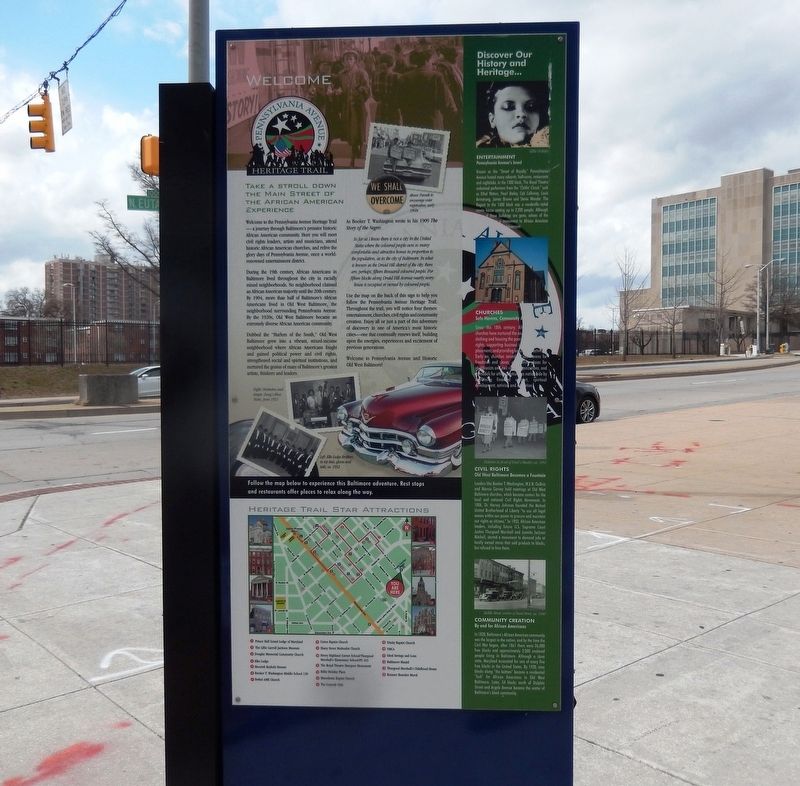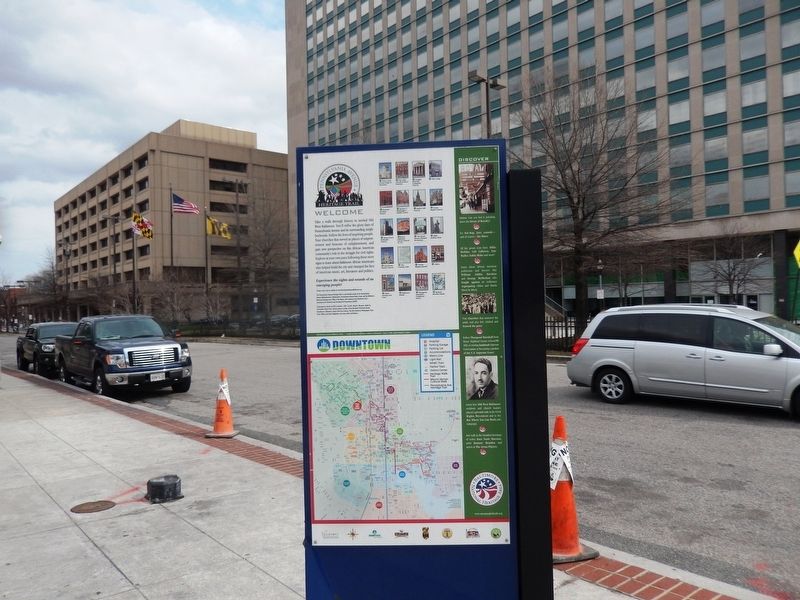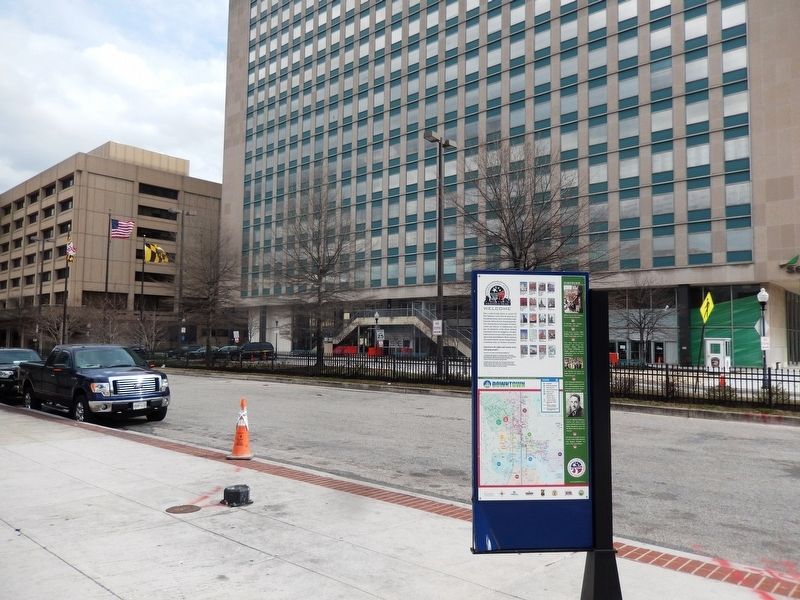Take a Stroll Down the Main Street of the African American Experience
Pennsylvania Avenue Heritage Trail
Welcome to the Pennsylvania Avenue Heritage Trail – a journey through Baltimore’s premier historic African American community. Here you will meet civil rights leaders, artists and musicians, attend historic African American churches, and relive the glory days of Pennsylvania Avenue, once a world-renowned entertainment district.
During the 19th century, African Americans in Baltimore lived throughout the city in racially mixed neighborhoods. No neighborhood claimed an African American majority until the 20th century. By 1904, more than half of Baltimore’s African Americans lived in Old West Baltimore, the neighborhood surrounding Pennsylvania Avenue. By the 1920s, Old West Baltimore became an extremely diverse African American community. Dubbed the “Harlem of the South,” Old West Baltimore grew into a vibrant, mixed-income neighborhood where African Americans fought and gained political power and civil rights, strengthened social and spiritual institutions, and nurtured the genius of many of Baltimore’s greatest artists, thinkers and leaders.
As Booker T. Washington wrote in his 1909 The Story of the Negro:
So far as I know there is not a city in the United States where the coloured people own so many comfortable and attractive homes in proportion to the population, as in the city of Baltimore.
In what is known as the Druid Hill district of the city: there are, perhaps, fifteen thousand coloured people. For fifteen blocks along Druid Hill Avenue nearly every house is occupied or owned by coloured people.
Use the map on the back of this sign to help you follow the Pennsylvania Avenue Heritage Trail. Throughout the trail, you will notice four themes: entertainment churches, civil rights and community creation. Enjoy all or just a part of this adventure of discovery in one of America’s most historic cities---one that continually renews itself, building upon the energies, experiences and excitement of previous generations. Welcome to Pennsylvania Avenue and Historic Old West Baltimore.
Discover our History and Heritage
(Inscriptions under the images on the right)
Entertainment
Pennsylvania Avenue’s Jewel
Known as the “Street of Royalty, Pennsylvania Avenue hosted many cabarets, ballrooms, restaurants, and nightclubs. In the 1300 block, The Royal Theatre welcomed performers from the “Chitin Great,” such as Ethel Waters, Pearl Bailey, Cab Calloway, Louis Armstrong, James Brown and Stevie Wonder. The Regent in the 1600 block was a vaudeville-styled movie house seating up to 2,200 people. Although all these buildings are gone, echoes of the past are a monument to African American achievement.
Churches
Safe
Since the 18th century, African American churches have nurtured the soul, while feeding, clothing and housing the poor; fighting for civil rights; supporting business initiatives and job placement; and providing leisure-time activities. Early on, churches served as safe havens for freedmen and slaves, meeting places for abolitionists and civil rights organizations, and models for other communities nationwide by creating financial support, spiritual development, activism and education.
Civil Rights
Old West Baltimore Becomes a Fountain
Leaders like Booker T. Washington, W.E.B. DuBois and Marcus Garvey held meetings at Old West Baltimore churches, which became centers for the local and national Civil Rights Movement. In 1886, Dr. Harvey Johnson founded the Mutual United Brotherhood of Liberty “to use all legal means within our power to procure and maintain our rights as citizens.” In 1933, African American leaders, including future U.S. Supreme Court Justice Thurgood Marshall and Juanita Jackson Mitchell, started a movement to demand jobs at locally owned stores that sold products to blacks, but refused to hire them.
Community Creation
By and for African Americans
In 1820, Baltimore’s African American community was the largest in the nation, and by the time the Civil War began, after 1861 there
Reverse Side of the Marker
Welcome
Take a walk through history in storied Old West Baltimore. You’ll relive the glory days of Pennsylvania Avenue and its surrounding neighborhoods. Follow the lives of inspiring people. Tour churches that served as places of empowerment and beacons of enlightenment, and gain new perspective on this African American community’s role in the struggle for civil rights. Explore at your own pace following these story signs to learn about Baltimore African Americans who helped build a city and changed the face of American music, art, literature and politics.
(Inscriptions under the images on the right)
1.Prince Hall Grand Lodge of Maryland
2.The Lillie Carroll Jackson Museum
3.Douglas Memorial Community Church
4.Elks Lodge
5.Morriah Keyhole Houses
6.Booker T. Washington Middle School
7.Bethel AME Church
8.Union Baptist Church
9.Sharp Street Methodist Church
11.The Royal Theatre Marquee Monument
12.Billie Holiday Plaza
13.Macedonia Baptist Church
14.The Comedy Club
15.Trinity Baptist Church
16.YMCA
17.Ideal Savings and Loan
18.Baltimore Masjid
19.Thurgood Marshall’s Childhood Home
20.Romare Bearden Mural.
Discover
(Inscriptions under the images)
*Listen, Can you feel it pulsating down the Street of Royalty?
*It’s bee-bop, jazz, comedy—and of course—the blues.
*All the greats were here. Billie Holiday, Cab Calloway, Fats Waller, Eubie Blake and more!
*Learn about African American politicians and lawyers like William Ashbie Hawkins and George McMechan who fought against an ordinance segregating whites and blacks block by block.
*Visit churches that nurtured the soul, and also fed, clothed and housed the poor.
*Follow Thurgood Marshall from Henry Highland Garnet School/PS 103, to winning landmark Supreme Court cases, to becoming a justice of the U.S. Supreme Court.
*Learn how Old West Baltimore residents and church leaders played a pivotal role in the Civil Rights Movement and in the Buy Where You Can Work jobs campaign.
*And walk in the creative footsteps of writer Zora Neale Hurston, artist Romare Bearden and actors at the Arena Players.
Topics. This historical marker is listed in these topic lists: African Americans • Churches & Religion • Civil Rights • Entertainment.
Location. 39° 18.096′ N, 76° 37.383′ W. Marker is in Baltimore, Maryland. It is in Madison Park. Marker is at the intersection of North Eutaw Street and West Preston Street on North Eutaw Street. Touch for map. Marker is in this post office area: Baltimore MD 21217, United States of America. Touch for directions.
Other nearby markers. At least 8 other markers are within walking distance of this marker. Trinity African Methodist Episcopal Church (about 700 feet away, measured in a direct line); Reflections (approx. 0.2 miles away); Neighbors and Natives (approx. 0.2 miles away); William Sydney Thayer, M.D. (approx. 0.2 miles away); Woodrow Wilson (approx. 0.2 miles away); Mount Vernon Cultural District (approx. 0.2 miles away); Eubie Blake National Jazz Institute and Cultural Center (approx. 0.2 miles away); Breaking Boundaries: Reverence, Renovation, and Rock and Roll (approx. 0.2 miles away). Touch for a list and map of all markers in Baltimore.
Regarding Take a Stroll Down the Main Street of the African American Experience. "McMechan" found, apparently should have been "McMechen".
Credits. This page was last revised on March 17, 2021. It was originally submitted on March 4, 2017, by Don Morfe of Baltimore, Maryland. This page has been viewed 279 times since then and 12 times this year. Last updated on March 16, 2021, by Carl Gordon Moore Jr. of North East, Maryland. Photos: 1, 2, 3. submitted on March 4, 2017, by Don Morfe of Baltimore, Maryland. • Bill Pfingsten was the editor who published this page.


